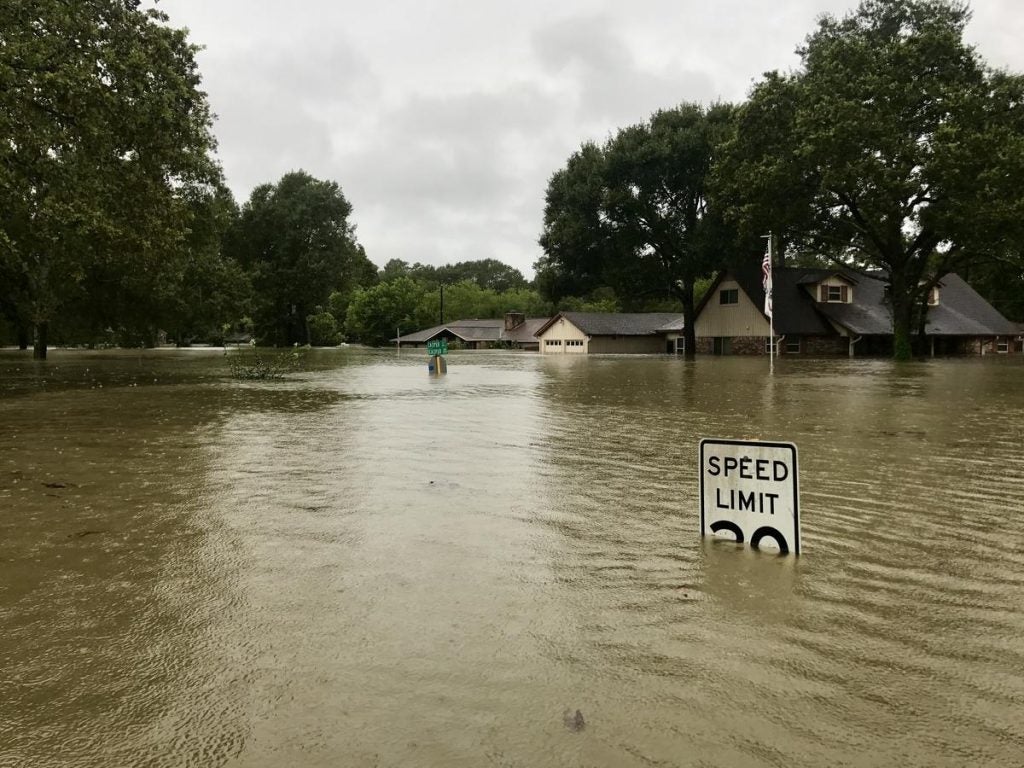A new report highlights the Trump administration’s dangerous efforts to obscure the real costs of climate change, while a major court decision firmly rejects the administration’s approach.

Costly flooding in a Houston area neighborhood in the aftermath of Hurricane Harvey.
A new report from the Government Accountability Office (GAO), an independent agency tasked with providing objective nonpartisan information to policymakers, confirms what we’ve known for years: that the Trump administration has been ignoring the enormous costs of climate change. By ignoring these damages, the administration is turning its back on communities across the nation who are footing the bill for those impacts today.
In addition, a federal court recently issued a clear-cut rejection of the administration’s deceptive math on the cost of methane pollution, another greenhouse gas that is 84 times more potent than carbon dioxide over a 20 year time period. This ruling reinforces the fact that the administration has been blatantly disregarding widely accepted science and economics when it comes to the costs of climate change.
All of this comes amid a raging and widespread pandemic that underscores the absolute necessity of relying on experts and scientific data when crafting policy. With unchecked climate change fueling more devastating storms, droughts, and other public health impacts — all of which hit vulnerable communities the hardest — incorporating accurate costs of climate change in policy decision-making matters now more than ever.
Here is what this new report and court decision reveal about the administration’s backwards and harmful approach to decisions on climate change — and how experts and the courts are wholly rejecting it.
Why undervaluing the cost of climate change is dangerous
To justify its own political agenda, the Trump administration has manipulated the calculations behind the estimated impact of emissions to allow for more climate pollution from major sources like power plants and cars. The new GAO report outlines the steps the administration has taken to drastically underestimate the “Social Cost of Carbon” — a measure of the economic harm from climate impacts that is used to inform policy and government decision-making. These impacts include extreme weather events like flooding and deadly storms, the spread of disease, and sea level rise, increased food insecurity, and more.
After a 2008 court decision requiring the federal government to account for the economic effects of climate change in regulatory benefit-cost analysis, an Interagency Working Group (IWG) comprised of experts across a dozen federal agencies began in 2009 to develop robust estimates of the social costs of carbon that could be used consistently by agencies across the government. These estimates were developed through a transparent and rigorous process based on peer-reviewed science and economics that included input from the National Academy of Sciences and the public — and were periodically updated over time to account for the latest science. More recently, the NAS conducted a thorough assessment to provide guidance on updating the social cost of carbon estimates and suggestions for continuing to build on and strengthen it.
The GAO report underscores the importance of implementing those recommendations, while pointing to the fact that the federal government has done absolutely nothing to follow through. In fact, in 2017 the Trump administration recklessly disbanded the IWG — the very federal entity that already had the mandate to take on this task.
Since then, federal agencies like the EPA have been relying on an “interim cost” to inform important regulatory decisions that is seven times lower than the IWG’s estimate — a move that dramatically underestimates the profound impacts climate change has on families, businesses, taxpayers and local governments. To make matters worse, the administration is dramatically reducing the IWG figure even though it is widely recognized to be an underestimate of the true costs. There is wide consensus that the true costs are much likely significantly higher.
The Trump administration substantially reduces estimates through two key flaws in its calculations, both of which fly in the face of established science and economic principles. First, the reduced estimates ignore that carbon emissions are a global pollutant, omitting important categories of climate change impacts on the United States. Second, they undervalue the harm to our children and future generations by significantly over-discounting future climate impacts.
By vastly undervaluing the costs of climate change — and thus, the benefits of acting on climate — the administration has been able to justify rolling back critical protections such as the landmark federal Clean Car Standards. These important rules offer critical public health benefits and fuel savings for consumers.
A court ruling refutes the administration’s deceptive math on pollution costs
In encouraging news, a recent court decision outright rejected the administration’s deceptive math on a similar metric, the ‘Social Cost of Methane,’ used to estimate the impacts of methane pollution. The Bureau of Land Management, under former Department of Interior Secretary Ryan Zinke, has been using an interim social cost of methane that is more than 25 times less than the estimate from the IWG. The U.S. District Court for the Northern District of California recently overturned the BLM’s attempt to ease protections from dangerous methane leaking, venting and discharging from oil and gas activities on public and tribal lands, where it used a distorted social cost of methane as justification. EDF joined the states of California and New Mexico and a broad coalition of health, environmental, tribal citizen and Western groups to challenge in court the rescission of these vital safeguards.
In the opinion, the judge ruled that the BLM’s decision to rely on a lower interim estimate for the social cost of methane was “arbitrary” and “capricious,” and therefore, “failed to quantify accurately the forgone methane emissions and the resulting environmental impacts.” In addition, the court underscored that “the President did not alter by fiat what constitutes the best available science” on the social cost of greenhouse gas emissions. This is a major win for not only the broad coalition involved in the case, but for the basic principle of science-based decision-making on climate change. The court’s meticulous critique of the flaws in the interim social cost of methane — and the process used to develop it — could be influential in future cases involving the social cost of greenhouse gas emissions. Such a critical ruling like this opens the possibility that the Trump administration and future administrations could be required to properly account for the costs of climate change.
The Trump administration’s unwavering, politically motivated attempts at twisting facts and discrediting experts is putting Americans’ lives, health and financial well-being at risk. Unfortunately, its effort to skew the costs of climate change is far more than a political game. It is already causing real harm to communities across the country suffering from climate impacts — and it will only add to the mounting costs our children and grandchildren will pay. That is why ongoing efforts to uncover and overturn unjust climate decisions are all the more essential.













 Co-authored by
Co-authored by